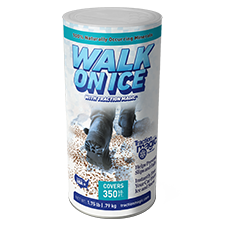How To Repair Concrete Damaged By Ice Melt
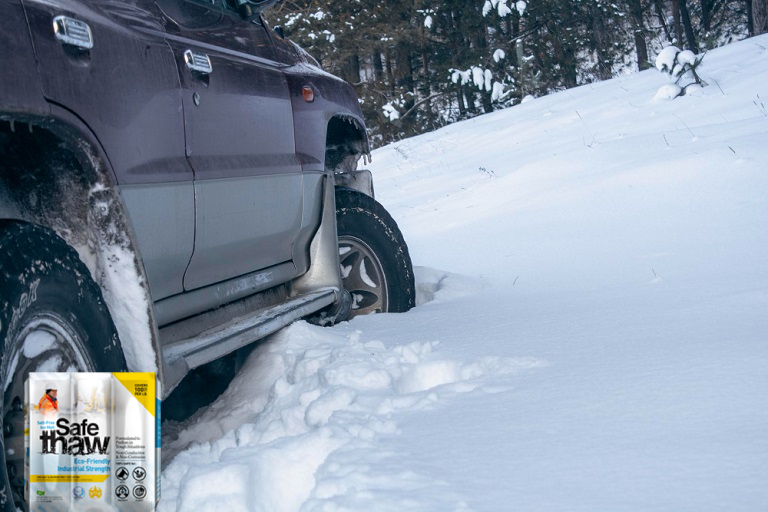
We choose the best ice melt for our homes, only to be disappointed at the end of the season to see the concrete get damaged. One of the biggest questions plaguing us is how to repair concrete damaged by ice melt. It usually happens when we do not exercise precaution while choosing the right ice melt or when we overuse the product, thinking it will melt ice faster. But that is not so. If you are still looking for viable solutions to repair damaged concrete, it is time to look at quick fixes right here!
Safest Ice Melt for Concrete: How to Repair and Protect Damaged Surfaces
Winter can be tough on concrete surfaces, especially when harsh ice melt products accelerate damage. From scaling and discoloration to deeper cracks, ice melt chemicals can compromise the durability and appearance of your driveway, walkways, or patios. Understanding the safest ice melt for concrete and adopting preventative and repair techniques can help you preserve your investment for years to come.
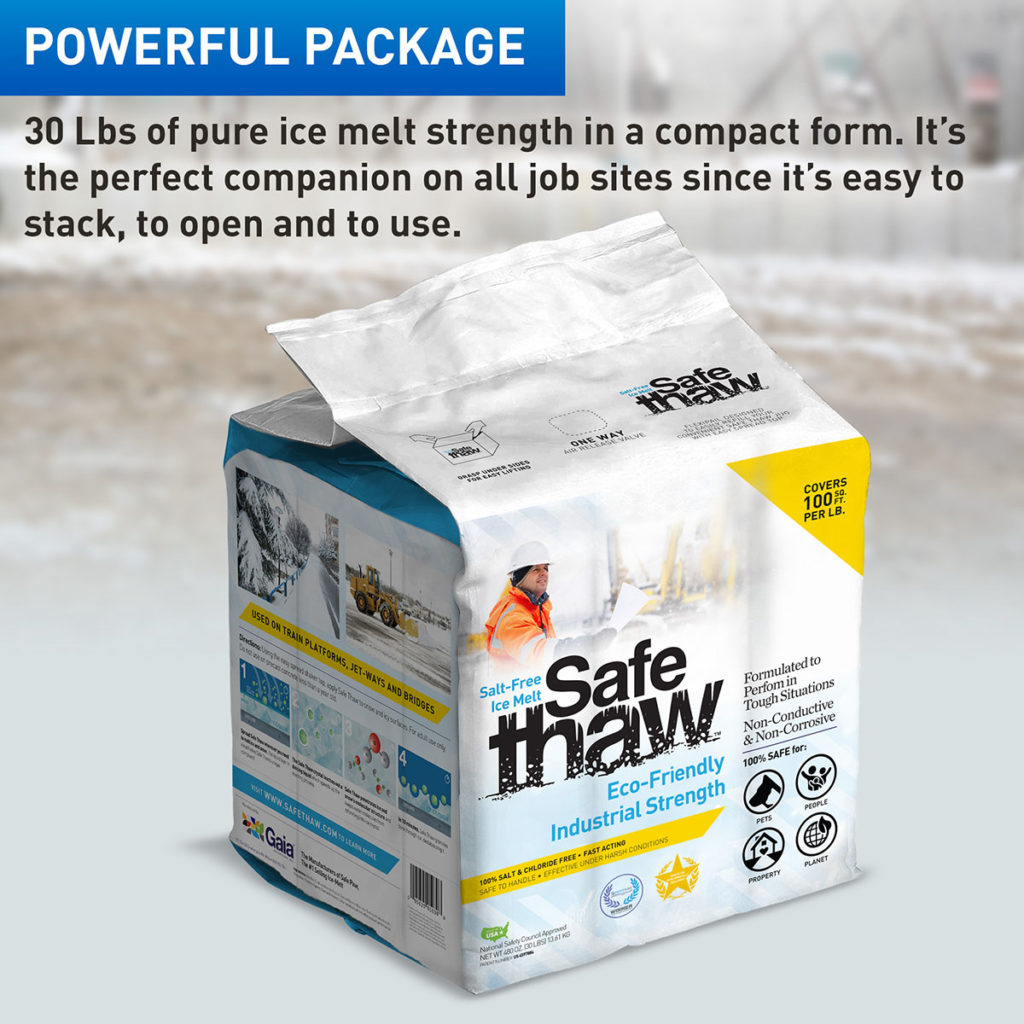
Safe Thaw
Safe Thaw was created as the ice management solution for tough winter environments. Ideal in commercial and industrial properties, shops, government agencies, bridges, and construction.
But before we jump to the repair part, we would like to apprise you of a product line that is 100% environmentally friendly and natural. Yes, it is Safe Thaw! It is a unique urea-modified product changing how homeowners melt ice on their driveway and battle winter woes. With superb ice-melting boosters with a liquid core, special surfactants, and glycols, you have one product that will take care of everything for you. From roofs to driveways, it is ideal for all surfaces and materials.
But we want to discuss something else here, do we? Let’s give you a quick run-through of the different ways you can repair damaged concrete driveway and how much ice melt to use in case you didn’t know that already.
Concrete Sealants
Concrete sealants and caulks are thick adhesives manufactured keeping strength and durability in mind. They come in tubes and small tubs that you need to squeeze into the cracks and even it. They are ideal for fixing small cracks all over the driveway and do a great job of keeping bugs and water out.
Resurfacing Concrete Driveway
Clean the driveway of debris and wash it thoroughly. Mix the concrete resurfacer of any brand, such as Quikrete, and pour the mixture on the cracks. Use a flat-edged trowel to ensure the mix goes deep into the crevices, and let it dry overnight. It is an economical way to fix the concrete driveway. It will also help you solve your problem of how to repair concrete damaged by ice melt.
Instant Cement
A quick-fix cement solution is also a great way to fill the cracks. They are durable, easily available, and can be done at home. Pour the mixture into the cracks and see the magic overnight.
100% salt & chloride-free, fast acting Ice Management Solution
Identifying Early Signs of Ice Melt Damage
Recognizing early signs of damage caused by ice melt is crucial for timely intervention. Ice melt products containing harsh chemicals, such as sodium chloride or calcium chloride, can deteriorate concrete surfaces.
- Surface Discoloration: One of the first signs is discoloration, often appearing as white streaks or patches. These stains are caused by chemical residues left behind after the ice melt interacts with the surface.
- Minor Cracking: Small cracks may develop as water absorbed by the concrete freezes and expands during winter. These cracks, though minor at first, can worsen over time if left untreated.
- Flaking or Scaling: Flaking, also known as scaling, occurs when the top layer of concrete begins to peel or chip away. This is often due to the repeated freeze-thaw cycles aggravated by corrosive ice melt products. Addressing these issues early prevents them from escalating into more severe structural damage.
Preventative Measures to Protect Concrete from Ice Melt
Protecting your concrete surfaces from ice melt damage begins with proactive strategies. Here’s how you can safeguard your investment:
- Apply Protective Sealants: Sealants act as a barrier, preventing moisture and chemicals from penetrating the concrete. Apply a high-quality sealer before winter to enhance resistance to freeze-thaw cycles and deicing chemicals. Reapply every two to three years for continued protection.
- Choose the Safe Ice Melt for Concrete: Opt for products labeled as safe ice melt for concrete, like Safe Thaw. These chloride-free, non-corrosive alternatives are designed to melt ice effectively without causing scaling or spalling. They’re also safe for the environment, pets, and children.
- Implement Proper Snow Removal Techniques: Timely snow removal reduces the need for excessive ice melt application. Use plastic or rubber-edged shovels to avoid scratching the surface, and clear snow before it compacts into ice.
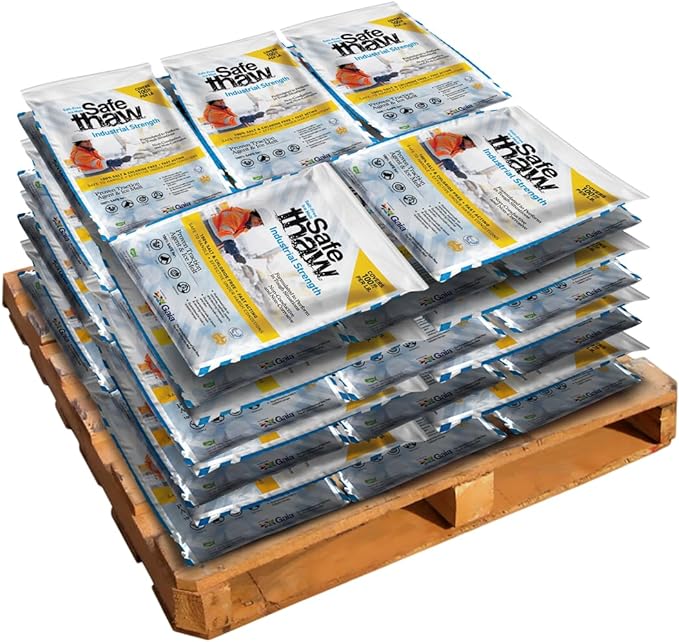
40 Bags
Safe Paw Thaw Industrial Strength Salt-Free Pet Safe Snow Ice Melter and Traction Agent for Concrete, Asphalt, Decks, Lawns, and More, 43 Pound Bag- 40 Bags
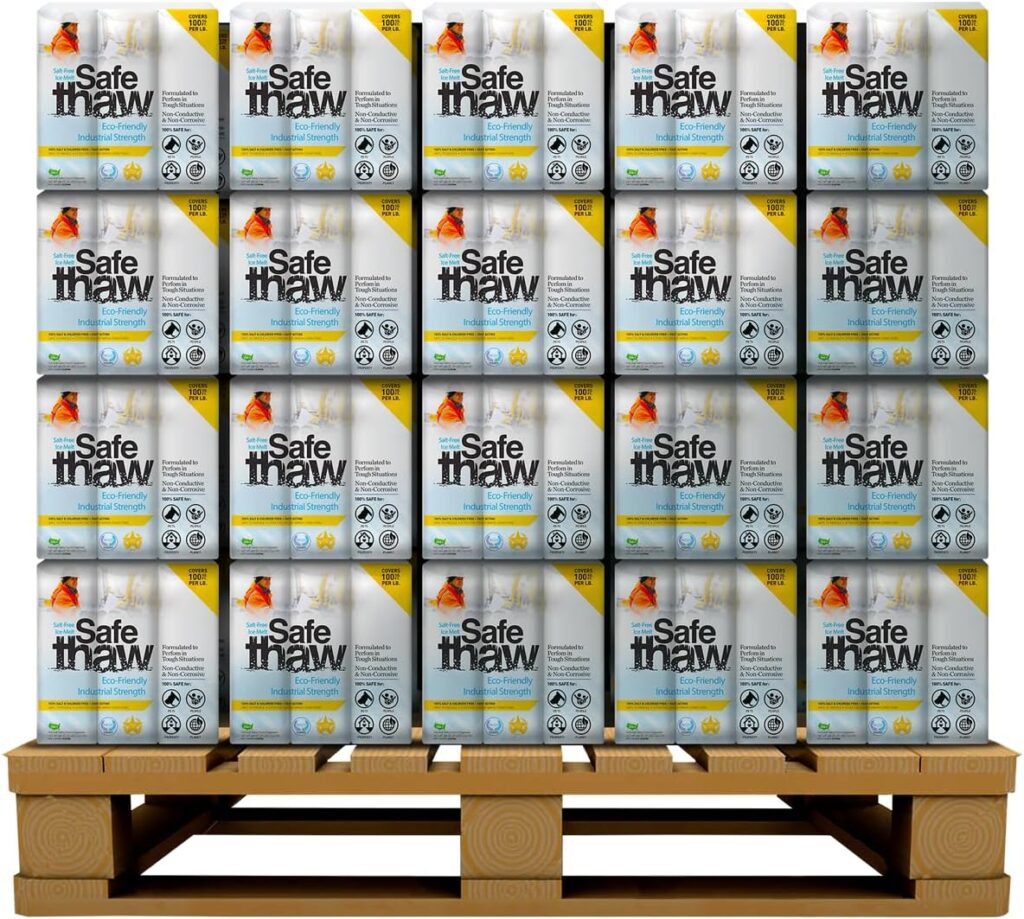
100 Boxes
Safe Thaw Industrial Strength 100% Salt/Chloride-Free, Pet/Paw-Safe Snow & Ice Melter and Traction Agent. Use on Concrete, Asphalt, Roofs & On Any Surface, 30 Pound FlexiPail- 100 Boxes
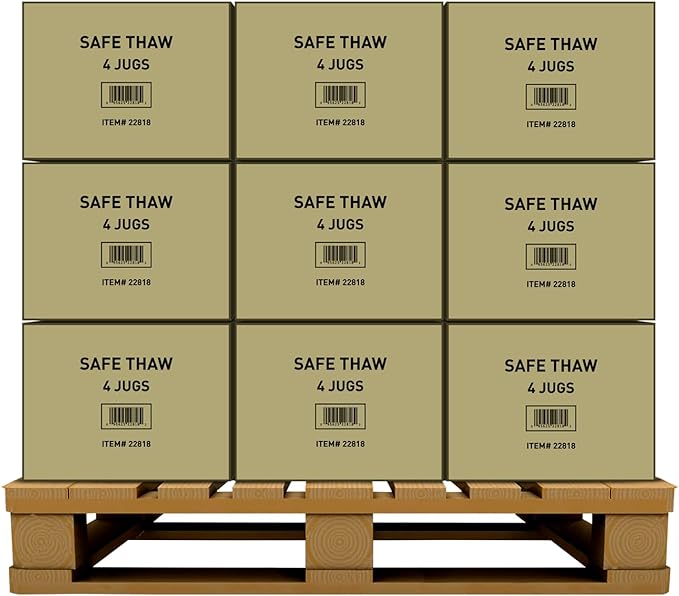
105 Jugs
Safe Thaw Concrete Safe 100% Salt-Free, Pet Safe Snow and ice Melter, Industrial Strength, Chloride-Free, and Traction Agent. Use on Asphalt, Roofs & On Any Surface, 10 Pound Jug- 105 Jugs
Environmental and Safety Considerations in Ice Melt Selection
Selecting the right ice melt goes beyond concrete protection—it also affects the environment and household safety.
- Ecological Impact of Ice Melt Chemicals: Traditional ice melt products containing chlorides can harm soil and vegetation. Runoff from these products often contaminates nearby water sources, disrupting aquatic ecosystems. Choosing environmentally friendly products reduces this impact while still keeping surfaces safe and ice-free.
- Safety for Pets and Children: Many ice melts are harmful if ingested or if they come into contact with skin. Pets are especially vulnerable, as chemicals can irritate their paws or cause gastrointestinal issues if licked. Similarly, children may accidentally ingest residue from surfaces. Non-toxic products like Safe Thaw eliminate these risks, offering peace of mind for families.
Long-Term Maintenance Practices for Concrete Durability
Regular maintenance enhances the longevity of concrete surfaces and prevents recurring damage from ice melt.
- Routine Cleaning: After winter, clean your concrete thoroughly to remove residual ice melt chemicals. Use a mild detergent and water or a pressure washer to eliminate stains and buildup.
- Address Minor Repairs Promptly: Fill small cracks as soon as they appear to prevent water infiltration and freeze-thaw damage. Use a concrete filler or patching compound to restore the surface and maintain its integrity.
- Periodic Sealing: Reapply a protective sealant every few years to reinforce the concrete’s resistance to moisture and deicing agents. This practice not only prevents scaling and cracking but also maintains the surface’s aesthetic appeal.
- Monitor Trex Decking Compatibility: While addressing winter concerns, it’s important to ask, can you put salt on Trex decking? The answer is no. Traditional salts can scratch and damage composite decking. Instead, use a safe, non-corrosive ice melt like Safe Thaw to protect your decking without compromising its durability.
Repairing Concrete Damaged by Ice Melt
If your concrete surfaces have already suffered damage, repairs can restore their functionality and appearance.
- Step 1: Assess the Damage : Inspect the concrete for cracks, discoloration, or flaking. Determine whether the damage is superficial or structural to choose the appropriate repair method.
- Step 2: Clean the Surface : Remove debris, dirt, and any chemical residue using a pressure washer. For stubborn stains, use a specialized concrete cleaner to prepare the surface for repair.
- Step 3: Fill Cracks and Apply Patch : Use a concrete patching compound to fill cracks and repair flaking areas. Smooth the surface with a trowel and allow it to cure as per the product’s instructions.
- Step 4: Reapply Sealant : Once repairs are complete, apply a protective sealant to prevent future damage. Ensure the sealant is compatible with safe ice melt products for optimal results.
The Hidden Price for Concrete Driveway Ice Melt Damage: More Than Just Cracks
When concrete begins to show signs of wear from ice melt, many assume it’s a minor issue—just a small crack here or some scaling there. But the truth is, the hidden costs add up quickly. Once moisture penetrates the surface, every freeze-thaw cycle works against the integrity of your driveway. Left unchecked, what started as surface-level damage could require a full resurfacing or even replacement.
And here’s the kicker—if you’ve ever looked up the price for concrete driveway replacement, you know it’s not cheap. Depending on region and material costs, you could be looking at anywhere from $5 to $15 per square foot. Compare that to the far lower cost of preventive sealing or using a concrete-safe ice melt, and it becomes clear: prevention isn’t just smart, it’s economical.
How Long Does It Take For Salt To Damage Concrete?
This is one of the most common questions people ask. The frustrating answer? It depends. In some cases, noticeable pitting or scaling may appear after just one harsh winter. In others, it may take several years of repeated chloride exposure for the damage to show up.
The process is slow but relentless. Salt, whether sodium chloride, calcium chloride, or magnesium chloride, dissolves into the meltwater and seeps into pores. Once inside, it accelerates freeze-thaw expansion and sometimes even triggers chemical reactions that weaken the concrete internally. So while you might not see the damage immediately, the clock starts ticking the moment salt makes contact with unsealed surfaces.
Can Concrete Actually Melt?
Another question that comes up often is: what temperature does concrete melt? The answer might surprise you. Concrete doesn’t actually “melt” in the traditional sense. It’s a composite material made up of cement, sand, and aggregates, and rather than melting, it begins to break down when exposed to extreme heat.
In fact, concrete can withstand very high temperatures—above 1,000°F—before it begins to chemically decompose. So, no, your driveway isn’t going to melt under normal conditions. However, it doesn’t take extreme heat to damage it. The real threat in winter is salt, moisture, and freezing temperatures—not melting, but expansion, cracking, and scaling.
How To Fix Salt Damaged Concrete
If you’re already dealing with salt damage, don’t panic. There are proven strategies to bring your driveway or walkway back to life:
- Surface Cleaning – Start by washing away residues thoroughly. A pressure washer works well, but make sure to use a fan tip to avoid causing further surface damage.
- Crack Repair – Small cracks can be filled with polymer-modified concrete patching compounds. For best results, clean and slightly widen the crack before applying the filler to ensure good bonding.
- Resurfacing – For widespread scaling, a resurfacer may be your best option. Applied as a thin overlay, it gives your driveway a fresh, uniform appearance while also providing a new protective surface.
- Protective Sealants – Once repairs are complete, don’t skip sealing. A high-quality, breathable concrete sealer will limit moisture absorption and extend the lifespan of your repair work.
Looking Ahead: Prevention Is Always Cheaper Than Repair
Ultimately, the best way to deal with damage is to prevent it before it happens. Using chloride-free ice melts, clearing snow promptly, and applying protective sealants are all cost-effective ways to extend the life of your driveway.
Think of it like this: investing in protection now could save you from the hefty price for concrete driveway replacement later. The choice between minor maintenance and major reconstruction really comes down to how proactive you are during winter.
Conclusion
Concrete is tough, but it’s not invincible. The lingering question of how long does it take for salt to damage concrete should be enough to make any property manager think twice before scattering chlorides across a surface. While concrete doesn’t melt under normal conditions—so no need to worry about its melting temperature—it does deteriorate quickly when exposed to salt-laden water and freeze-thaw cycles.
If your surface is already showing wear, learning how to fix salt damaged concrete through cleaning, patching, resurfacing, and sealing can restore functionality and extend lifespan. More importantly, adopting proactive winter strategies, including the use of non-chloride ice melt solutions, ensures your driveway or commercial property remains safe and intact year after year.
At the end of the day, prevention always costs less than repair. Taking care of your concrete now not only saves you money but also ensures you won’t be staring down the steep price for concrete driveway replacement sooner than expected.
Try Also Our Other Winter Safety Products:
Safe Paw
The Original and #1 Selling Pet and Child Safe Ice Melt for over 20 years. Guaranteed environmentally safe –It won’t harm animals or children, and it won’t damage your property. That’s Safe Paw. Safe Paw can change how winter affects our planet.

Walk On Ice
The handy disposable canister can be taken everywhere, with the same 100% naturally occurring minerals that provide instant traction on ice or snow. Use it on sidewalks, steps, or as an instant traction agent for your car.
